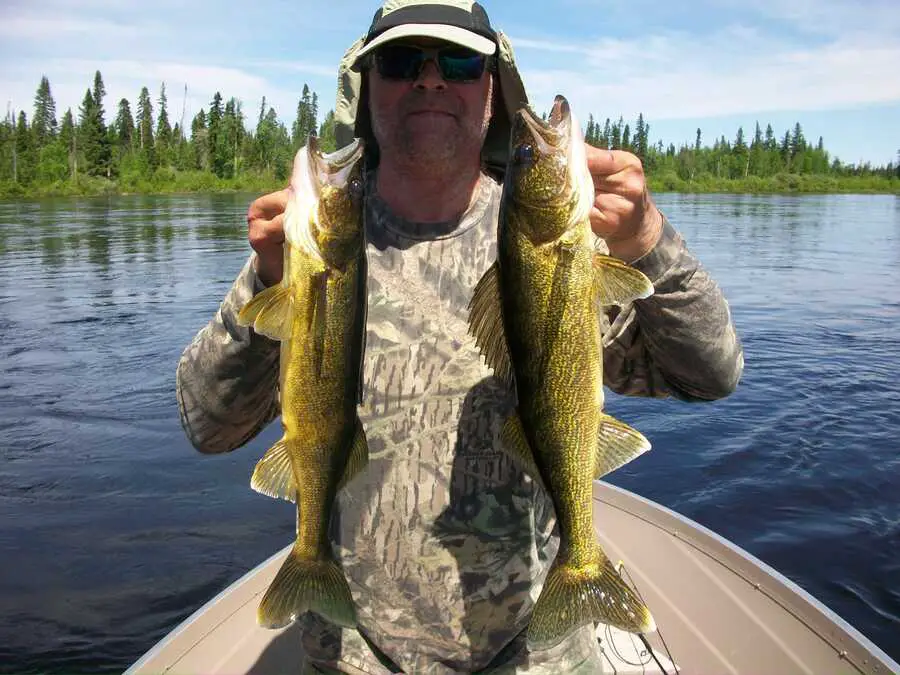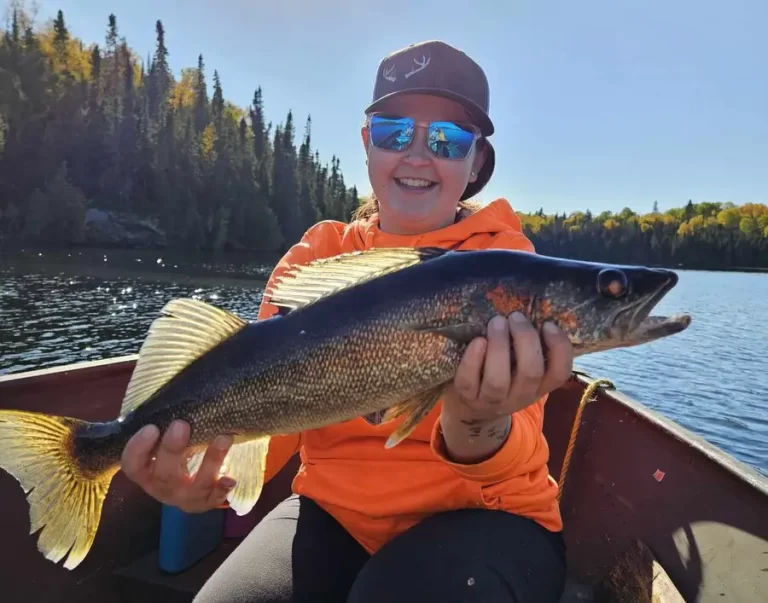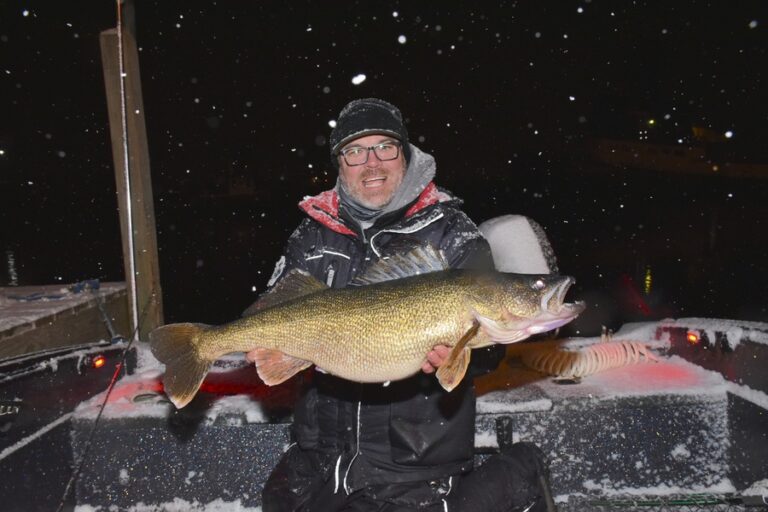What Walleye Eat (Seasonal Guide) Are They Bottom Feeders?
Walleye predominantly feed on smaller fish such as perch, minnows, and shad, along with aquatic insects, crayfish, and worms. Their diet varies based on the availability of prey in their specific habitat and seasonal changes.
| Food Source | When Consumed |
|---|---|
| Zooplankton and small aquatic insects | Consumed by young walleye |
| Yellow perch, minnows, freshwater drum | Consumed by mature walleye throughout the year |
| Aquatic insects (e.g., mayflies), crayfish, snails, mudpuppies, salamanders, frogs, leeches | Consumed by mature walleye, particularly when other food options are limited |
| Small bass, trout, pike, perch, bluegill | Consumed throughout the year, with prime feeding |
In my seasonal fisheries management positions and years of walleye fishing experience, I have learned a lot from other professionals/anglers on what walleye eat throughout the year. I have participated in numerous walleye stomach contents studies.

Table of Contents
What Walleye Eat
Walleye primarily eat other fish in lakes and rivers. Their diet changes as they grow, starting with zooplankton and small aquatic insects when they are young. As they mature, walleye mainly eat other fish such as yellow perch, minnows, and suckers.
They also consume aquatic insects like mayflies, crayfish, snails, mudpuppies, salamanders, frogs, and leeches. Walleye are opportunistic feeders and will broaden their diet to include almost any organism they can catch when food options are limited. Feeding mainly occurs during dawn and dusk.
Knowing what walleye eat throughout the year will increase the odds in your favor. I love fishing with perch and shad patterns. Ghost colors are my favorite for walleye in summer and fall. Blade baits and jigging spoons are my favorite winter baits.
For a complete breakdown of on if walleye are dangerous to humans, check out this helpful guide. You may also be interested in this article breaking down how big a walleye should be to get mounted.
Seasonal Variations in Walleye Diets
Spring
In spring, walleyes are more concerned with reproduction than feeding, making them harder to catch. However, post-spawn, they begin feeding vigorously, primarily in shallow waters during the night. As the water warms, their activity level increases, leading to phases of more aggressive feeding.
During the early morning and late evening, they feed in shallow areas near spawning grounds. As the day progresses, they tend to move away from the shallows to avoid bright sunlight.
In spring, as water temperatures rise and ice melts, walleye tend to feed aggressively in preparation for spawning.
In spring, walleye eat:
- small fish like minnows
- yellow perch
- juvenile fish of various species that are more abundant and active during this time.
Summer
During summer, walleyes move to deeper, cooler waters during the day due to increased water temperatures. Their heightened metabolism during this period drives them to feed more frequently. Insects and crustaceans make up a large part of smaller walleye diets in summer.
In summer, walleye eat:
- small to medium-sized fish, including shad, sunfish, and larger minnow species in summer
- leeches
- crayfish
My favorite summertime walleye baits are either live perch or perch-pattern lures like crankbaits or spoons trolling around deep structure like humps, ledges, and inside turns.
Fall
Dropping temperatures in fall brings out changes in walleye behavior as they prepare for winter. Early fall sees walleyes returning to the shallows to feed in response to declining water temperatures. Walleye are gearing up for winter and building fat stores.
They remain quite active during this period, often hunting in large schools. As winter approaches, walleyes gradually retreat to deeper waters, although they continue feeding aggressively to build fat reserves for the upcoming winter.
In fall, walleye eat:
- schooling fish like shad, alewives, shiners, and perch
- large insects
- crayfish
- leeches
Leeches and shad-patterns are my favorite fall baits for lakes. In lakes, shad patterns are the best.
Winter
During the winter, walleye eat around half as much food as they do in summer. Despite having a slower metabolism, walleyes still feed throughout the winter.
During the winter, they tend to occupy a much smaller home-range than you’d find in summer. On smaller lakes, walleye generally stay close to warm-weather structures such as large humps, deeper edges of long points, and inside turns.
In winter, walleye eat:
- lethargic baitfish like herring, smelt, and perch
- dead or dying baitfish
- any remaining insects and crayfish
Top or Bottom: Are Walleye Bottom Feeders?
While walleye spend much of the day feeding near bottom, they will adjust to factors such as temperature, light, oxygen, and food and feed throughout the water column. They inhabit various levels of the water column, often dictated by environmental conditions like light, temperature, and prey availability.
During the day, walleye tend to stay in deeper, darker waters due to their light sensitivity, emerging to shallower areas or near the surface during low-light conditions like dawn, dusk, or on overcast days.
Factors such as water clarity, oxygen levels, and seasonal changes also influence their position in the water column. For instance, in colder months, they might move to deeper areas, while in warmer seasons, they’ll frequent a mix of depths depending on prey movement and water temperature.

Pro Tips: Based on What Walleye Eat
Spring Feeding Habits: Post-spawn, walleye are in shallow waters. Use smaller jigs and minnows as bait, mimicking the juvenile fish they feed on.
Light Sensitivity: Walleye are light-sensitive; fish for them during low-light conditions like dawn, dusk, or overcast days for better results.
Summer Deep Diving: In summer, walleye move to cooler, deeper waters. Use deep-diving lures and bottom bouncers to reach them.
Crayfish Imitation: When walleye feed on crayfish, use crayfish-colored crankbaits or soft plastics that mimic their movement.
Fall Forage: In fall, walleye prepare for winter and feed aggressively. Use larger baits like full-sized crankbaits and spinnerbaits that mimic perch or shad.
Winter Slowdown: During winter, walleye metabolism slows. Use smaller, more subtle jigs and live bait, and fish slowly.
Weed Edge Fishing: Walleye often hunt near weed edges. Cast along these areas, especially where there are sudden depth changes.
Nighttime Feeding: Walleye are active at night. Use glow-in-the-dark lures or baits for visibility.
Prey Movement Mimicry: Imitate the movement of walleye’s natural prey. Use a stop-and-go retrieve to mimic injured fish.
Use Live Bait Effectively: When using live bait like minnows or leeches, ensure they are lively to attract walleye effectively.
Trolling Techniques: Try trolling along drop-offs and submerged structures, as walleye often hunt in these areas.
Seasonal Transition Zones: Pay attention to areas where shallow water meets deep water, especially during seasonal transitions.
Rocky Bottoms: Fish in areas with rocky bottoms or structures, as walleye often feed around these for crayfish and small fish.
Barometric Pressure: Fish before a storm when the barometric pressure is dropping; walleye tend to feed more actively during these times.
Wind-Driven Food: Fish on the windward side of lakes or rivers, as the wind can push baitfish into these areas, attracting walleye.
Frequently Asked Questions
Do walleye hit topwater?
Walleye rarely hit topwater lures, as they primarily feed in middle to lower water columns. However, they may strike topwater in certain conditions, like during low-light periods (dawn or dusk) or when prey fish are active near the surface, prompting an opportunistic feeding behavior.
They will occasionally hit topwater when walleye are working deep weed edges or strongly wind-swept shorelines. A popper or floating stick bait like a Rapala could catch some topwater walleye under these conditions.
Are walleye predators?
Walleye are predatory fish. They are known for their sharp teeth and keen hunting skills, preying on various smaller fish and aquatic creatures.
Do walleye eat gobies?
Walleye do eat gobies. This opportunistic feeding behavior allows walleye to thrive in various aquatic environments, including those where gobies are present. Gobie-style baits like tubes and ned rigs work great.
Do walleye eat bluegill?
Walleye do eat bluegill, as they are opportunistic predators that feed on a variety of smaller fish, including bluegill, especially when they are readily available.
Do Walleye Eat Bass?
While walleye typically prefer smaller prey, they can occasionally eat young bass. Their diet mainly consists of smaller fish, making young bass a potential target.
Do Walleye Eat Crayfish?
Walleye eat crayfish, especially when other food sources are scarce. Crayfish form a part of their diverse diet, particularly in habitats where crayfish are abundant.
Do Walleye Eat Dead Fish?
Walleye generally prefer live prey but will consume dead fish if necessary. They are opportunistic feeders, adapting their diet based on availability. Especially during winter, dead fish can make up a large portion of the walleye’s diet.
Do walleye eat worms?
Walleye typically encounter worms more frequently as bait used by anglers rather than finding them naturally in their habitat. While they can eat worms in the wild, their presence in the walleye’s diet is significantly heightened through fishing practices.
Do walleye eat frogs?
While frogs occasionally do end up being eaten by walleye, they make up a very tiny amount of a walleye’s diet. When walleye move into shallower water near the edges of deep weed edges late evenings and night in summer, they may find a frog or two within striking range.
Do walleye eat perch?
Perch are one of the most important walleye baits in most walleye lakes and rivers. In some bodies of water, perch are the primary food source for walleye.






